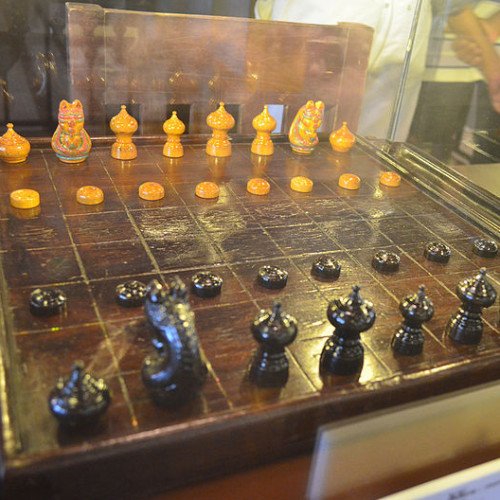MAKRUK VS SECTOR 41

MAKRUK
Makruk or Thai chess, is a board game that is descended from the 6th-century Indian game of chaturanga or a close relative thereof, and is therefore related to chess. It is classified as a chess variant. The word "ruk" (Thai: รุก) in Thai is thought to derive from "rukh" which means "chariot" in the Persian language (and is also the common origin of the name for a rook in western chess). The Persian traders came to the Ayutthaya kingdom around the 14th century to spread their culture and to trade with the Thai kingdom. It is therefore possible that the Siamese Makruk, in its present form, was directly derived from the Persian game of Shatranj via the cultural exchange between the two people in this period. This is because the movement of Makruk Thai's queen, or the "seed" (Thai: เม็ด), is essentially the same as the ferz in Shatranj. The disadvantaged player announces the counting of his fleeing moves, starting from the number of pieces left on the board, including both kings. The winning player has to checkmate his opponent's king before the maximum number is announced, otherwise the game is declared a draw. During this process, the count may restart if the counting player would like to stop and start counting again. For example, if White has two rooks and a knight against a lone black king, he has three moves to checkmate his opponent (the given value of 8 minus the total number of pieces, 5). If Black captures a white rook, the count does not automatically restart, unless Black is willing to do so, at his own disadvantage. However, many players do not understand this and restart the counting while fleeing with the king.
Statistics for this Xoptio

SECTOR 41
Sector 41 is a board game published by David Long and Michael Lachtanski of Scimitar Games. The game became available for pre-order in February 2009 and was officially released in April 2009. Sector 41 is a turn-based strategy game for two to four players. Game play takes place on a 9×9 grid of face-down tiles, randomly shuffled at the beginning of each game. Players control one mother ship which moves along the edge of the game board. Mother ships can deploy up to three explorer ships onto the face-down grid. Explorer ships are used to discover, mine, and tow deposits of Glynium to their mother ship. According to the game background, Glynium is an unstable power source only found in this sector. Victory is achieved when one player has mined more Glynium than any other player could match. In the case of a tie, the first person to reach that score is declared the victor. Sector 41 was developed from a compilation of game concepts developed by David Long and Michael Lachtanski, the earliest of which go back to the mid-1990s. The name itself is an homage to the popular Area 51 science fiction theme. Play testing began in late 2007 and lasted until production began in late fall of 2008. The face-down tile set up was conceived of to emulate the fog of war mechanism, popular in many computer games. The developers also encourage players to strategically manipulate the board layout for offensive and defensive purposes through the process of "folding space". This game mechanism was inspired by the Dune novels. The lengthy play time in the initial play testing lead developers to create the Guardian figure. The Guardian, described below, acts as a mechanism for rewarding exploration, expansion, and reduced play time dramatically. Additional rules for modifying the Guardian's role in gameplay are available on the Scimitar Games website. Michael Lachtanski designed the game's graphics. Many of the space graphics are based on images from NASA.